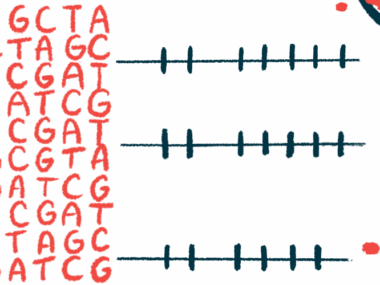Gene editing of SMN2 leads to normal SMN protein levels: Study
Scientists report early potential seen in CRISPR-based approach
Written by |

Researchers in the U.S. report using a gene-editing method to alter the SMN2 gene sequence, leading to normal levels of the survival motor neuron (SMN) — the protein that is lacking in spinal muscular atrophy — in early studies.
These results were obtained in a cell line derived from patients and a mouse model of the disease, with treated mice showing an amelioration of SMA symptoms. The scientists who developed the approach think it might overcome some limitations of current SMS treatments.
“Although our results are the initial steps towards a longer-term goal, the optimization of a single editing approach to treat all patients could eventually streamline progress into the clinic,” Benjamin Kleinstiver, PhD, an assistant investigator at the Center for Genomic Medicine at Massachusetts General Hospital, and the study’s principal investigator, said in a hospital press release.
The study, “Optimization of base editors for the functional correction of SMN2 as a treatment for spinal muscular atrophy,” was published in the journal Nature Biomedical Engineering.
SMN2 gene editing using an approach based on CRISPR
SMA is caused by mutations in the SMN1 gene, which provides instructions to produce the SMN protein. As a result, little or no SMN protein is produced, leading to motor nerve cell (neuron) damage and death.
Motor neuron loss leads to progressive muscle weakness and atrophy, mainly affecting movement but also often causing speaking, swallowing, and breathing difficulties.
Another gene called SMN2 provides instructions for making the SMN protein. But due to a slight difference in the gene sequence, SMN2 generates about 10% of functional SMN protein compared to SMN1. While SMN2 is known to compensate partly — a higher number of SMN2 copies associates with less severe disease in patients — it is unable to fully offset mutations in SMN1.
While three recent disease-modifying SMA treatments — the injection and oral therapies Spinraza (nusinersen) and Evrysdi (risdiplam), and the gene therapy Zolgensma (onasemnogene abeparvovec-xioi) — have led to notable improvements for patients, they are not definitive cures. Each also can have its own safety or efficacy concerns, or be limited to certain patient groups.
The researchers’ possible gene-editing method — a CRISPR-based approach — alters the sequence of the SMN2 gene to restore SMN protein levels. The approach is not dependent on a specific SMN1 disease-causing mutation.
They also noted that their research is complementary to another recent study of base editing in SMA models, published in the journal Science in April and supporting a one-time edit of the SMN2 gene.
CRISPR gene editing is a technology that allows scientists to modify genes within an organism. It works like a pair of molecular scissors to cut the DNA at specific locations, allowing researchers to add, delete, or replace genetic material.
Treatment given mice in SMA model restored SMN protein, eased symptoms
Researchers validated their approach’s safety and efficacy in skin cell lines obtained from SMA patients. They then used a genetically engineered and harmless adeno-associated virus (AAV) to deliver their CRISPR base editor to a mouse SMA model.
Results supported a precise editing of the SMN2 gene and restored SMN production, easing disease symptoms in the mice.
“By developing a single genome editing strategy to correct SMN2 to enable high levels of SMN protein expression, our approach could avoid the need to correct different types of mutations in the SMN1 gene,” said Kleinstiver, who is also an assistant professor of pathology at Harvard Medical School.
Several steps still are needed in advancing this approach, including tests into whether combining it with approved SMA treatments maximizes efficacy, and the possibility of base editor delivery using lower AAV doses or an alternative to an adeno-associated virus, which some patients cannot use.
“Continued development of our base editing approach should provide a long-lasting genetic treatment for SMA, where a durable one-time edit offers major advantages compared to existing therapies,” said Christiano Alves, an assistant investigator at the Center for Genomic Medicine and the study’s first author.







